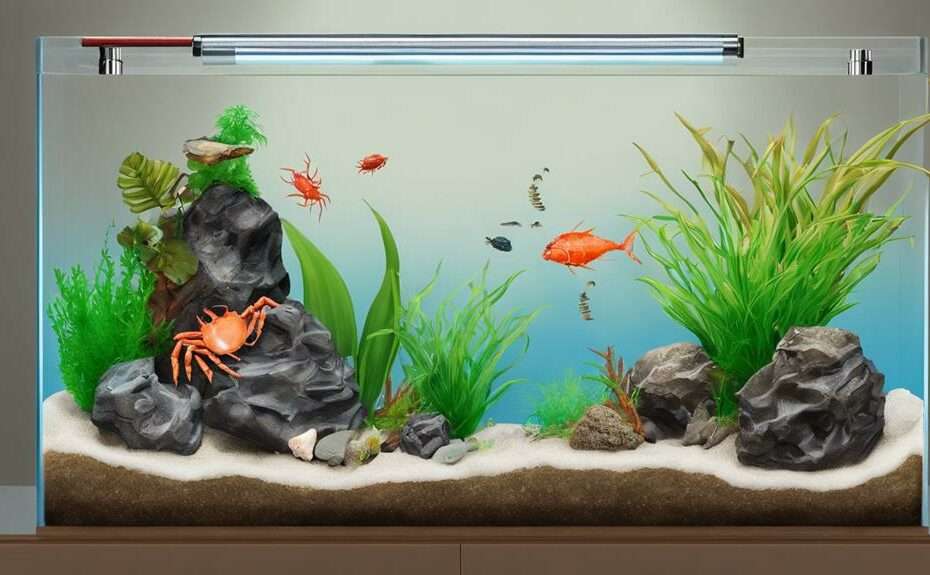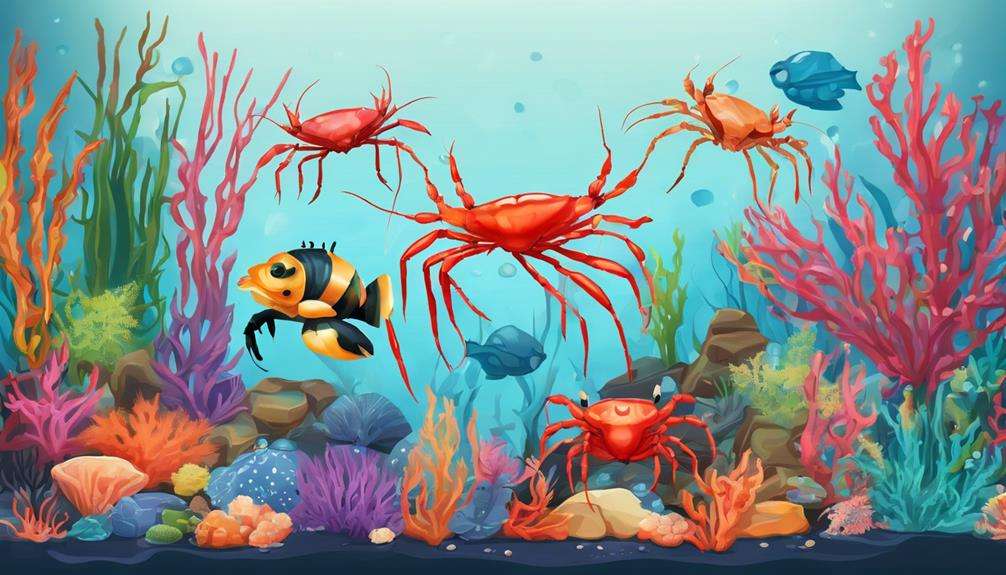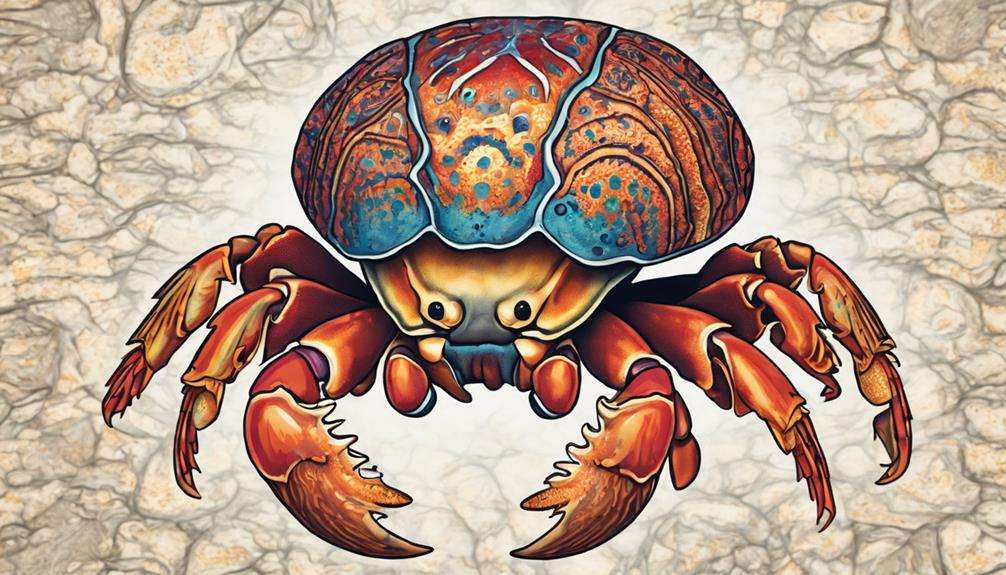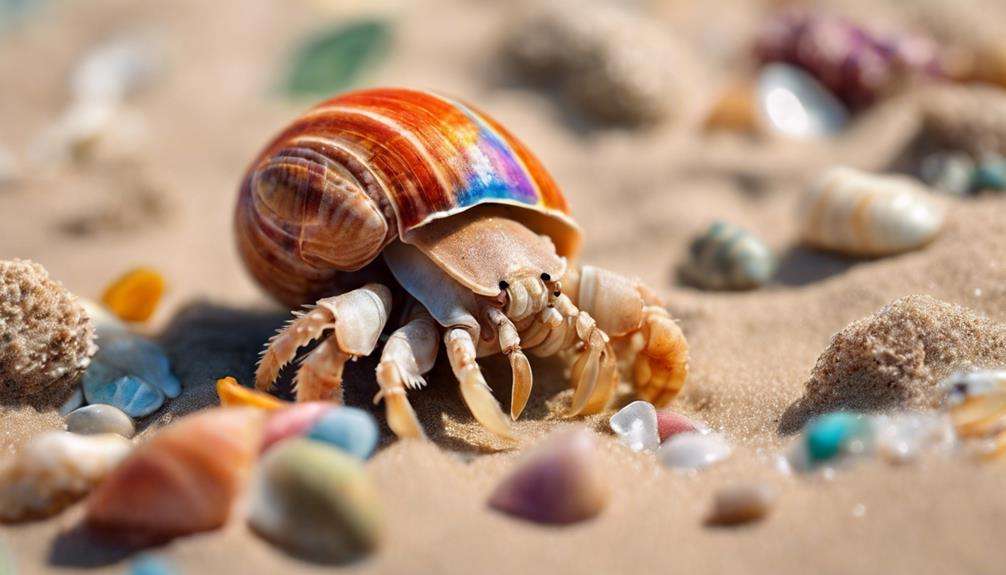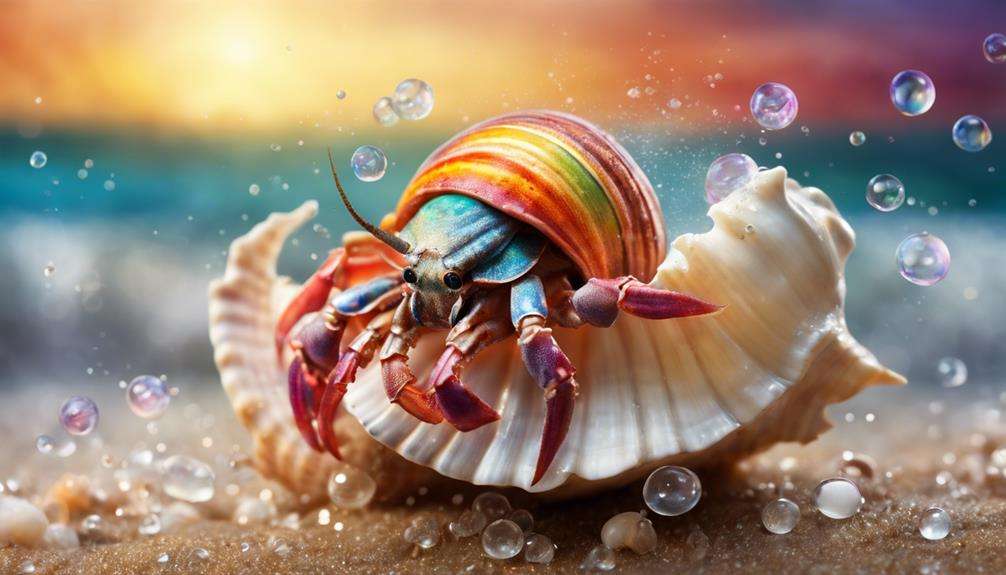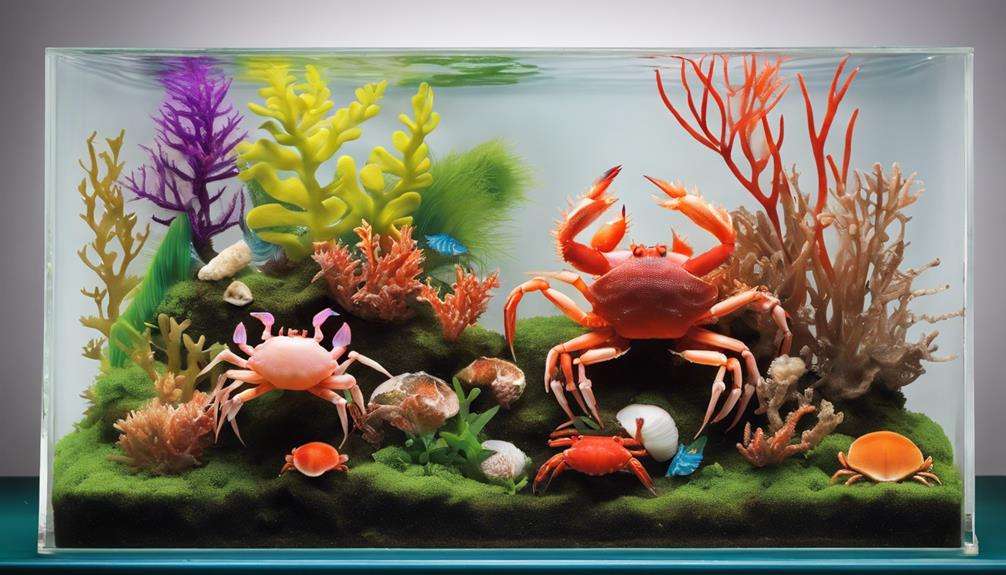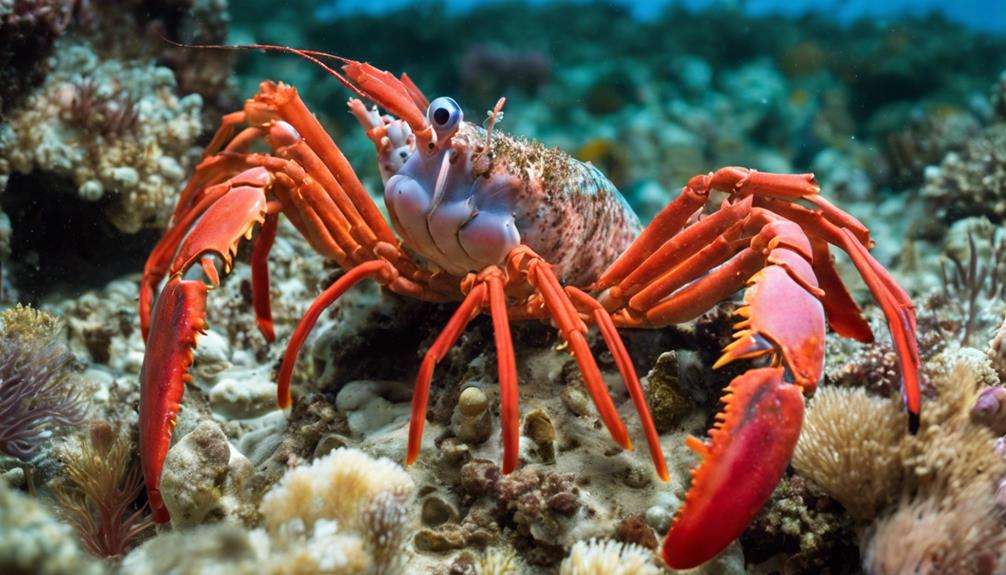Setting up a specialized crustacean habitat can seem like an overwhelmingly complex task, with various elements to carefully consider. From tank selection to maintaining optimal temperature and humidity levels, each aspect plays a crucial role in creating a suitable environment for these creatures.
However, there is one key factor that often gets overlooked but can significantly impact the well-being of your crustaceans.
Key Takeaways
- Choose appropriate tank size and setup based on crustacean needs
- Provide suitable substrate for burrowing and moisture retention
- Maintain proper humidity levels and water quality for health
- Ensure a balanced diet and prompt care for overall well-being
Tank Selection
When selecting a tank for specialized crustacean habitats, opt for a size ranging between 5 to 20 gallons based on the specific needs and quantities of crustaceans intended for housing. It's crucial to ensure that the tank has secure lids to prevent any potential escapes and to maintain proper humidity levels within the enclosure. Additionally, having a mounded surface or areas above the waterline is essential for crustaceans to access areas where they can breathe air comfortably.
To create an optimal habitat for crustaceans, it's important to provide hiding spots and spaces for them to explore. Tanks equipped with essential accessories such as filters, heaters, UVB lights, and thermometers contribute significantly to maintaining the right conditions for these creatures. Adequate space for decor like pebbles, sand, and plants not only enhances the aesthetics of the tank but also provides enrichment and hiding spots for the crustaceans to feel secure in their environment.
Choosing the Right Substrate
Selecting the appropriate substrate for your crustacean habitat is crucial for their well-being. Consider materials like coconut fiber, sand, or a blend that promotes burrowing and retains moisture effectively.
Ensure the substrate is deep enough to allow for natural behaviors and enrichment.
Substrate Types
For optimal crustacean habitat setup, carefully choose a substrate like coconut fiber, sand, or a blend of both to promote burrowing and maintain moisture levels. The substrate plays a crucial role in maintaining proper humidity levels, which are essential for the well-being of your crabs.
Coconut fiber is excellent for retaining water, creating a humid environment that mimics their natural habitat. Sand provides a suitable substrate for burrowing behavior, allowing the crabs to exhibit their natural instincts. A blend of both substrates can offer the benefits of moisture retention and burrowing opportunities.
Depth Considerations
To facilitate burrowing behavior in hermit crabs, ensure that the substrate depth ranges between 6 to 8 inches, allowing for adequate tunneling space and support for molting activities. A mix of sand and coconut fiber substrate in the tank encourages burrowing and aids in moisture retention.
It's crucial to maintain a substrate that's compact enough to hold tunnels but loose to enable digging and molting processes. For molting crabs, provide extra substrate depth to support this critical phase.
Regularly monitor moisture levels in the substrate to prevent compaction or excessive dryness, as these conditions can impact the overall habitat suitability for crustaceans. Keeping these depth considerations in mind will help create a comfortable and natural environment for your hermit crabs.
Maintenance Importance
To ensure the optimal habitat setup for your hermit crabs, the maintenance of the appropriate substrate is of utmost importance for their well-being and natural behavior expression. When selecting a substrate for your crustaceans' environment, consider the following:
- Choose Wisely: Select substrates like sand, coconut fiber, or a mix to create a habitat that mimics their natural environment and supports their burrowing instincts.
- Maintain Humidity Levels: The right substrate helps in maintaining proper humidity levels essential for the health and comfort of your crustaceans.
- Ensure Cleanliness: Regularly monitor and clean the substrate to prevent health issues and provide a clean and comfortable living space for your hermit crabs.
Temperature Control
Maintain the temperature of the crustacean habitat within the optimal range of 75-85°F (24-29°C) using heating pads or under tank heaters to ensure a warm and stable environment for the crustaceans.
Temperature control is crucial for the well-being of crustaceans as they're sensitive to fluctuations. Heating pads or under tank heaters are effective tools to regulate the temperature within the habitat.
Regularly monitor the temperature levels to guarantee they remain within the recommended range. Extreme temperature variations should be avoided as they can induce stress in the crustaceans, affecting their health.
Providing a consistent and warm environment supports the metabolic functions and overall health of the crustaceans. By implementing these temperature control measures, you can create an ideal habitat for your crustaceans, promoting their comfort and vitality.
Lighting Essentials
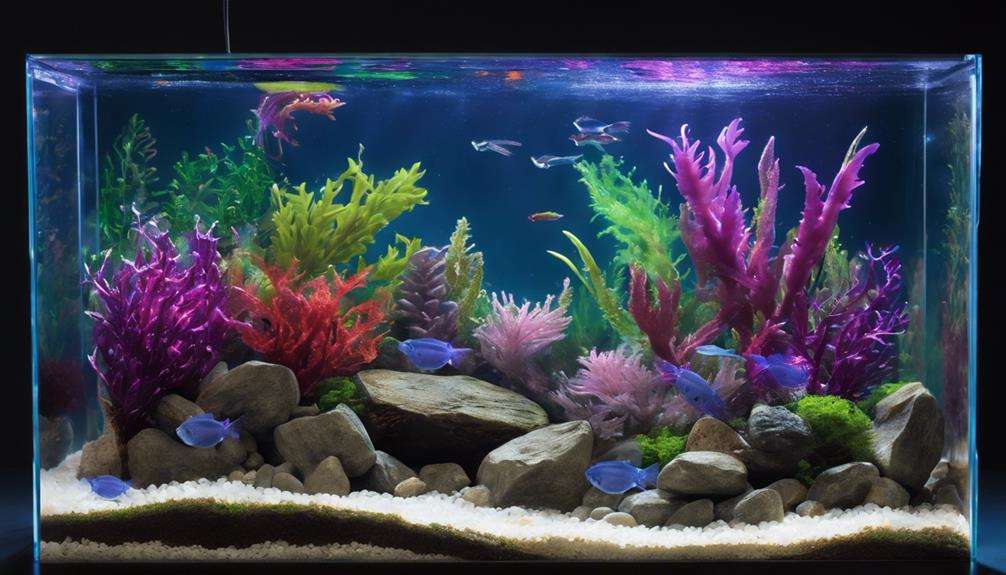
For optimal habitat conditions, ensure that low-wattage bulbs are provided to simulate natural lighting in the crustacean environment. When setting up the lighting for marine hermit crabs, it's crucial to consider the following:
- Implement a 12-hour light-dark cycle: Regulating a consistent light-dark cycle helps mimic the natural environment of marine hermit crabs, promoting their activity and rest patterns.
- Utilize full-spectrum lighting: Full-spectrum lighting supports the hermit crabs' natural behaviors and overall health by providing a balanced spectrum of light similar to sunlight.
- Monitor lighting duration and intensity: Regularly check and adjust the duration and intensity of the light to ensure it aligns with the needs of the marine hermit crabs. Avoid excessive lighting that may disrupt their natural rhythm or cause stress.
Humidity Requirements
Consider the essential humidity requirements to create an optimal habitat for your crustaceans, ensuring their health and well-being. Maintaining a humidity level between 70-80% is crucial for the well-being of crustaceans in captivity.
To accurately monitor and adjust humidity levels, use a hygrometer in the habitat. Providing water dishes and sea sponges can help regulate humidity by increasing moisture in the air. Ensure access to both fresh water and salt water in deep dishes to meet their hydration needs.
When preparing salt water, dechlorinate the water first and then add marine aquarium salt to create a suitable saline solution for the crustaceans. By meeting these humidity requirements, you create a habitat that mirrors their natural environment, promoting their health and overall well-being.
Monitoring and maintaining the humidity level within the recommended range will help prevent issues related to dehydration and ensure a comfortable living space for your crustaceans.
Cage Decor Tips
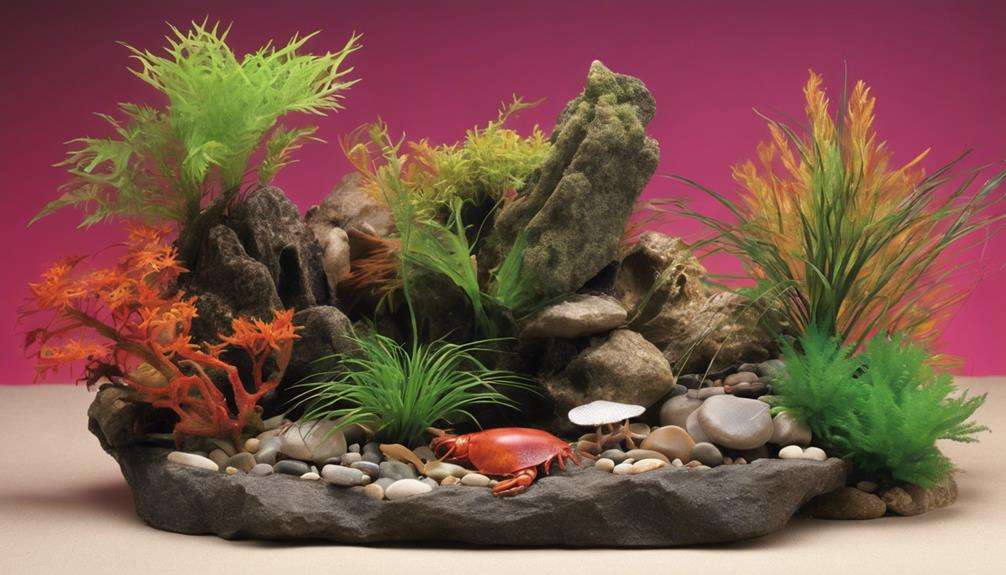
Incorporate natural elements such as driftwood, rocks, and caves to provide essential hiding spots and climbing opportunities for crustaceans in their habitat. These elements not only serve as shelters but also encourage natural behaviors, contributing to the well-being of your crustaceans.
To create a diverse and engaging environment, consider the following:
- Provide a mix of pebbles, sand, and plants: This combination offers varied textures and hiding places, mimicking the crustaceans' natural surroundings and promoting exploration.
- Include slopes and mounded surfaces: By incorporating different elevations, crustaceans can exhibit their climbing abilities and engage in natural foraging behaviors.
- Utilize UVB lighting: This type of lighting helps simulate natural sunlight, which is crucial for the overall health and development of your crustaceans, promoting their activity levels and enhancing their well-being.
Water Quality Management
Maintain optimal water quality by monitoring pH levels within the range of 7.5 to 8.5. Conduct weekly water tests to ensure the proper balance is maintained.
Remember to change 10-25% of the water biweekly or monthly to keep the environment clean.
Filter for Clean Water
Select a high-quality aquarium filter that matches the size of your crustacean habitat to effectively manage water quality. When choosing a filter, consider its capacity to handle the water volume and waste produced by your crustaceans. Opt for a filter that offers mechanical, biological, and chemical filtration for optimal water quality maintenance. Regularly cleaning and maintaining the filter is crucial to prevent the accumulation of waste and debris, ensuring its efficiency. Monitoring water parameters such as ammonia, nitrite, and nitrate levels is essential to guarantee that the filter is effectively maintaining clean water for your crustaceans.
Key Points:
- Choose an appropriate filter capacity.
- Opt for mechanical, biological, and chemical filtration.
- Regularly monitor water parameters.
Monitor Ph Levels
To ensure optimal water quality in the crustacean habitat, regularly monitor pH levels between 8.0 and 8.3 using pH test kits to maintain stability.
Fluctuations in pH can stress crustaceans, leading to potential harm. By keeping acidity levels within the recommended range, you support the well-being and longevity of your crustaceans.
High or low pH levels can have adverse effects on shell growth and molting processes, crucial aspects of crustacean health. Monitoring pH levels is essential for creating a suitable environment for your crustaceans.
Feeding Guidelines
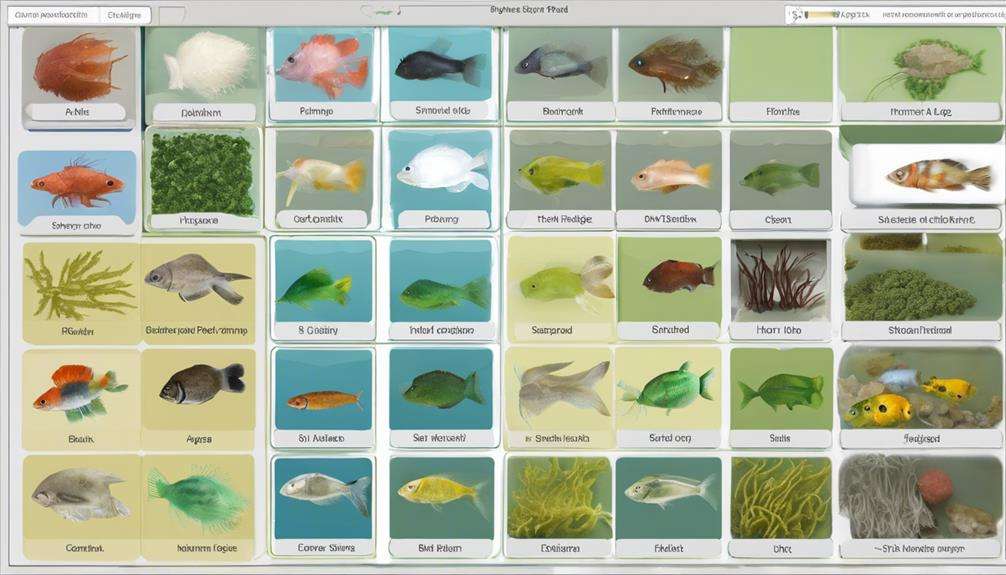
Regularly offer a balanced diet consisting of vegetables, fruits, and proteins to ensure the nutritional requirements of crustaceans are met. It's essential to provide a variety of foods to supply the necessary nutrients for their well-being.
Here are important guidelines to consider when feeding your crustaceans:
- Include Calcium-Rich Foods: Incorporate calcium-rich sources like cuttlebone, kale, or broccoli into their diet to support molting processes and maintain shell health.
- Avoid Overfeeding: Overfeeding can lead to food spoilage, impacting water quality and potentially causing health issues for the crustaceans. Offer appropriate portions to prevent wastage and maintain a clean habitat.
- Monitor Feeding Habits: Observing how the crustaceans consume their food can provide insights into their health. Ensure they're actively eating, and promptly remove any uneaten food to prevent mold growth and maintain a hygienic environment. By closely monitoring their feeding habits, you can adjust their diet as needed to support their nutritional needs effectively.
Handling and Care Techniques
When caring for crustaceans, it's important to handle them gently to minimize stress and reduce the risk of injury during routine care procedures. Different crustacean species, such as hermit crabs, have specific needs and behaviors that should be understood to provide effective care. When picking up crustaceans, use proper techniques to ensure their safety and well-being. Create a stress-free environment within their habitat to promote their overall health. Monitor crustaceans closely for any signs of illness, injury, or distress, such as changes in behavior, appetite, or shell condition.
During care routines, be mindful of how you interact with your crustaceans. Approach them calmly and avoid sudden movements that could startle them. When handling them, support their bodies properly to prevent any unnecessary stress. Remember to wash your hands before and after handling them to avoid transferring any harmful substances. By following these care techniques and maintaining a watchful eye on their well-being, you can help ensure a comfortable and thriving environment for your crustacean companions.
Common Health Concerns
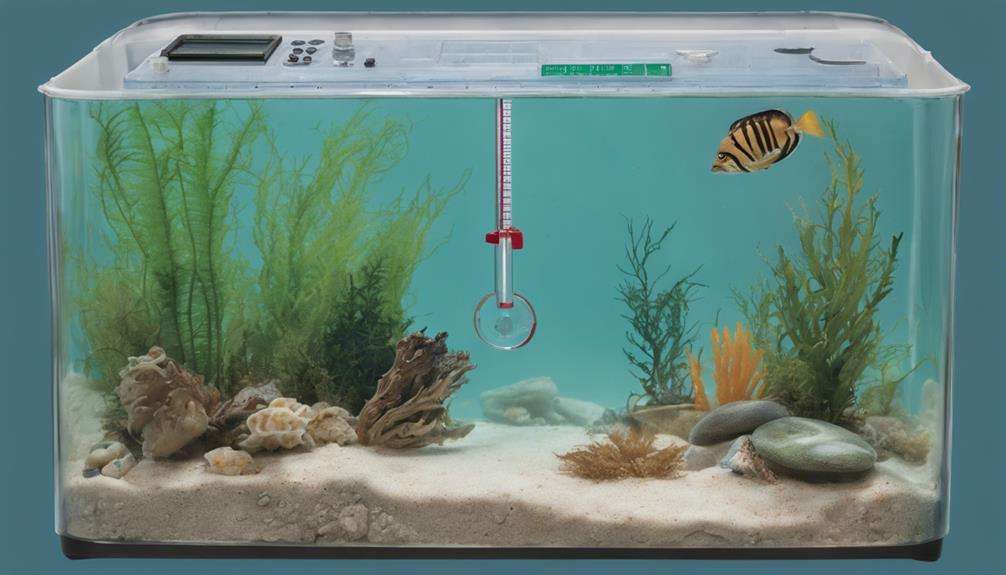
Common health concerns for crustaceans encompass a range of issues, including shell injuries, shell rot, molting problems, and bacterial infections. These issues can significantly impact the well-being of your hermit crabs in a specialized habitat. To ensure the optimal health of your crustaceans, it's crucial to address these common concerns promptly. Here are key points to consider:
- Shell Injuries: Shell injuries can arise from fights among hermit crabs, poor shell conditions, or a lack of suitable shell options. Regularly inspect your crustaceans for any signs of shell damage and provide a variety of appropriately sized shells for them to change into.
- Shell Rot: Shell rot, a fungal infection that affects the shell, can be triggered by poor water quality or a deficiency in calcium. Maintain pristine water conditions and offer calcium-rich foods to prevent shell rot in your hermit crabs.
- Molting Issues: Molting problems, such as unsuccessful molting or being trapped in the molt, pose life-threatening risks to crustaceans. Ensure a stress-free environment, proper nutrition, and adequate humidity levels to support successful molting processes in your hermit crabs.
Frequently Asked Questions
How Do You Set up a Crab Habitat?
When setting up a crab habitat, choose an appropriate tank size, provide suitable substrate, select decor to mimic natural surroundings, maintain proper humidity and temperature levels, and establish a feeding schedule to ensure the well-being of your crab species.
How Do You Make a Crab Habitat?
To make a crab habitat, choose an appropriate tank size, decorate with natural elements, set up proper water parameters, offer suitable substrate, provide adequate lighting, and maintain controlled temperature. Ensure the crab's species requirements are met.
How Many Hermit Crabs Can You Have in a 10-Gallon Tank?
You can comfortably house 1-2 small hermit crabs in a 10-gallon tank. Consider species size and behaviors when determining tank capacity. Adequate space is crucial for molting and shell changes, preventing stress and aggression.
What Are 3 Adaptations of a Crab?
Crabs exhibit remarkable adaptations for survival: molting to grow, exoskeleton protection, and camouflage for defense. Their feeding behaviors, communication signals, mating rituals, and social hierarchy are intricate aspects of their complex ecosystem interactions.
Conclusion
In the intricate ecosystem of a specialized crustacean habitat, each element plays a vital role in maintaining the delicate balance of life. Just as the tides ebb and flow, the careful selection of tank, substrate, temperature, and nutrition creates a harmonious environment for these fascinating creatures to thrive.
By tending to every aspect with precision and care, you aren't just a caretaker, but a steward of a miniature world where beauty and complexity intertwine.
